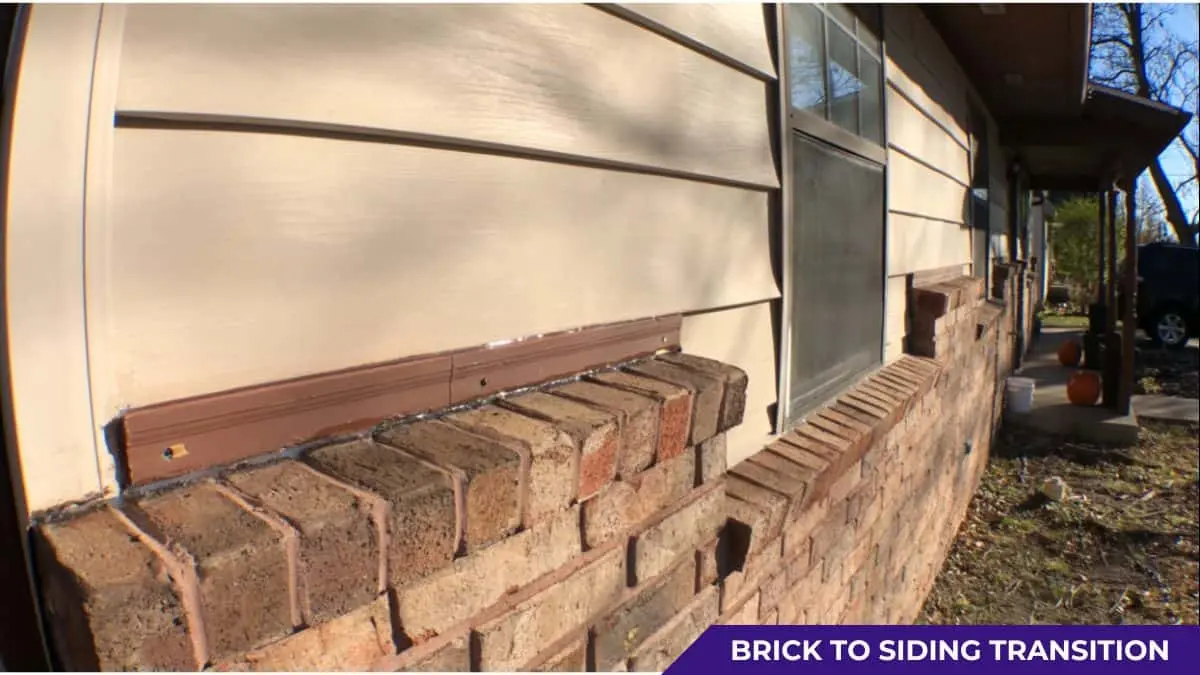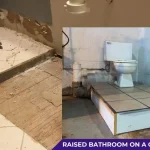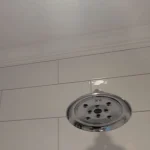Transitioning from brick to siding is an increasingly popular choice for homeowners looking to modernize their home’s exterior. This shift allows for greater design flexibility, reduced maintenance, and potential energy savings. Brick to siding transitions can completely change the look of a home, making it more contemporary while also enhancing its durability and insulation.
In this post, we’ll explore why homeowners choose this transition, the different types of siding available, and the step-by-step process involved. We’ll also cover common challenges, costs, and expert design tips to ensure your home looks and functions at its best after the change.
Why Homeowners Choose to Transition from Brick to Siding
Many homeowners are choosing to replace their brick exterior with siding for several reasons. This decision often stems from a desire to modernize the home’s appearance, reduce maintenance needs, or improve energy efficiency. Let’s explore the most common motivations for this transition and the specific benefits that siding offers over traditional brick.

Aesthetic Modernization
One of the most common reasons homeowners transition from brick to siding is to update the look of their home. Brick, while classic, can often make homes appear dated, especially if the brick has weathered or faded over time. Siding provides a more modern and versatile appearance, with a wide range of textures, colors, and finishes that can suit both contemporary and traditional styles. Homeowners can easily customize the look of their home with siding, which allows them to break away from the uniformity that brick often imposes.
In addition, siding offers options for blending materials like stone veneers or trim accents, creating a more dynamic and visually appealing exterior. This kind of flexibility is not as readily available with brick, which usually limits design choices to the color and texture of the masonry.
Flexibility in Design
When it comes to design, siding offers far more flexibility than brick. With siding, homeowners can choose from various materials, including vinyl, fiber cement, wood, and even metal. These materials come in a wide range of colors and finishes, providing endless possibilities to customize the look of the home.
Unlike brick, which usually comes in earthy tones, siding allows for bold color choices, ranging from neutral tones to brighter shades, offering homeowners a chance to make a unique statement. Siding also provides more options for texture—whether a homeowner wants the look of smooth panels, wood grain, or even stone-like finishes, there’s a siding material that can achieve that vision.
Maintenance Considerations
Homeowners also choose to replace brick with siding because of reduced maintenance. While brick is often praised for its durability, it is not maintenance-free. Over time, brick can crack or chip, and the mortar joints between bricks can deteriorate, leading to the need for repointing or repairs. Cleaning brick can also be labor-intensive, as it requires careful handling to prevent damage to the surface.
In contrast, most siding materials require minimal upkeep. Vinyl siding, for instance, only needs occasional cleaning with a hose or pressure washer to maintain its appearance. Materials like fiber cement and composite siding are highly resistant to weathering, insects, and rot, reducing the need for ongoing maintenance or repairs. As a result, switching to siding can save homeowners both time and money in the long run.
Cost-Effective Renovation
The cost of repairing or restoring brickwork can be significant, especially if large areas of the brick exterior are damaged or if the home requires repointing. In contrast, installing siding can often be more affordable, depending on the material chosen. Siding offers a cost-effective solution for homeowners who want to refresh their home’s exterior without the high costs associated with brick repair or replacement.
Additionally, siding installation is often faster and less labor-intensive than masonry work, which can further reduce costs. The ability to install siding directly over brick (in some cases) also helps minimize labor and material expenses. Homeowners who want to achieve a fresh look while keeping costs down often find that siding is the better option.
Energy Efficiency and Insulation
Another key reason for the brick-to-siding transition is the potential for improved energy efficiency. Traditional brick walls, especially in older homes, often lack proper insulation, which can lead to heat loss in the winter and heat gain in the summer. This can result in higher energy bills and an overall less comfortable living environment.
Modern siding materials, particularly those with built-in insulation, can greatly enhance a home’s thermal performance. Insulated siding helps regulate indoor temperatures, reducing the strain on heating and cooling systems. As a result, homeowners can benefit from lower energy bills and a more energy-efficient home overall.
The Benefits of Siding Over Brick
Siding has become an increasingly popular choice among homeowners looking to upgrade or replace their brick exteriors. This is largely due to the versatility, durability, and cost-effectiveness that siding offers in comparison to brick. Let’s delve into the specific benefits that make siding a preferred option over brick.

Durability and Weather Resistance
Siding, especially materials like fiber cement and vinyl, is designed to withstand various weather conditions far better than traditional brick. While brick can crack or erode over time due to moisture, freeze-thaw cycles, and impacts, modern siding materials are built to resist these forces. For example, fiber cement siding is known for its resistance to extreme weather, rot, and pests. This level of durability ensures that the siding maintains its appearance and integrity for decades, with minimal wear and tear, making it a more reliable option for areas with harsh climates.
Customization and Aesthetic Flexibility
One of the most compelling advantages of siding over brick is the broad range of customization options it offers. Siding comes in a variety of styles, textures, and colors, which allows homeowners to achieve any look they desire, from classic to contemporary. Brick, on the other hand, is much more limited in its range of finishes and colors.
With siding, homeowners can mimic the look of wood, stone, or even traditional brick, all while enjoying the lower maintenance requirements associated with siding. The ability to mix and match materials—such as combining siding with stone veneer or other accent elements—further enhances the home’s curb appeal and allows for personalized design choices.
Energy Efficiency and Insulation Properties
Another key benefit of siding is the potential for improved energy efficiency. Many siding materials are available with built-in insulation, which helps regulate the home’s temperature throughout the year. Insulated siding creates a thermal barrier that prevents heat loss during winter and minimizes heat gain during summer. This is a major advantage over brick, which lacks these insulating properties and can contribute to energy loss if the home is not properly insulated internally.
Lower Installation and Maintenance Costs
Installing siding typically involves lower labor and material costs compared to repairing or replacing a brick exterior. Brick masonry is labor-intensive and requires skilled masons to complete, making it both time-consuming and expensive. Siding installation, by contrast, can often be completed more quickly and with less specialized labor. This makes it a cost-effective solution for homeowners looking to update their home’s exterior without incurring significant expenses.
In terms of maintenance, siding outperforms brick in several areas. Brick requires regular inspections for cracks, mortar erosion, and moisture damage, all of which can be costly to repair. Siding, especially vinyl and fiber cement, requires minimal upkeep, with occasional cleaning being the most common maintenance task. This low-maintenance aspect makes siding a more appealing choice for busy homeowners.
Ease of Repair
While brick repairs can be costly and require professional assistance, siding offers a much simpler repair process. If a panel or section of siding becomes damaged, it can usually be replaced individually without disturbing the rest of the exterior. This ease of repair ensures that homeowners can maintain the appearance and functionality of their siding without having to invest in costly repairs. In contrast, repairing damaged brick often involves extensive masonry work, which can be both disruptive and expensive.
Types of Siding Options for Brick Replacement
When considering a transition from brick to siding, homeowners are faced with a wide range of siding materials to choose from. Each type offers unique benefits in terms of appearance, durability, and maintenance. Below, we’ll explore the most popular siding options available for replacing brick, helping homeowners make an informed decision that aligns with their design preferences and budget.
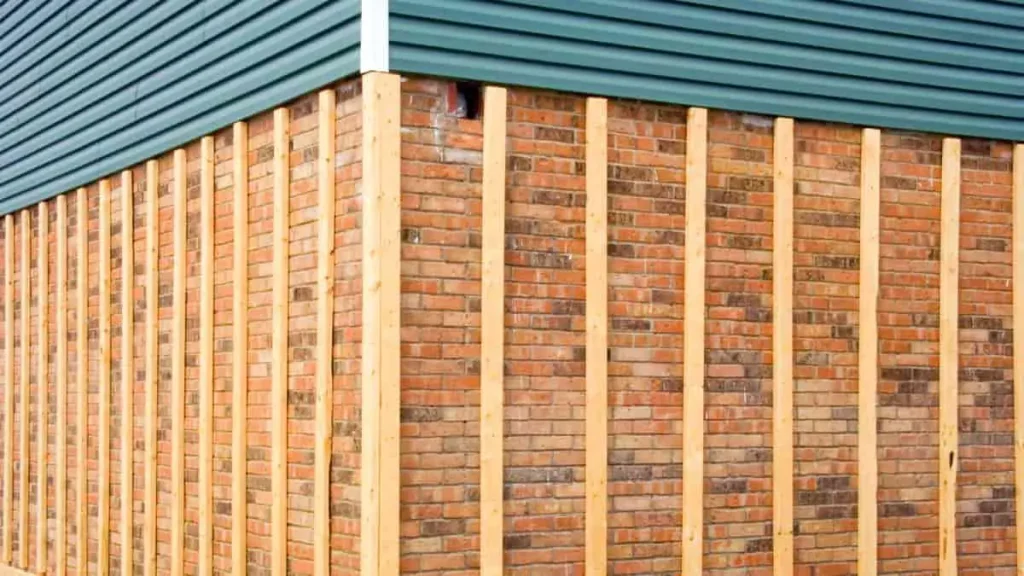
1. Vinyl Siding
Vinyl siding is one of the most common and affordable options available for replacing brick. Known for its low cost, ease of installation, and minimal maintenance requirements, vinyl siding is an attractive choice for budget-conscious homeowners. It comes in a wide variety of colors and styles, allowing homeowners to customize their home’s exterior to their liking. Vinyl siding is also resistant to moisture, insects, and rot, making it suitable for various climates.
One of the key advantages of vinyl siding is that it does not require painting or sealing, reducing maintenance over time. However, while vinyl is durable, it can be susceptible to cracks or warping in extreme weather conditions. Despite this, its affordability and flexibility make vinyl siding a popular choice for those looking to modernize their home without breaking the bank.
Recommended: How to Update Vinyl Siding
2. Fiber Cement Siding
Fiber cement siding, often referred to by the brand name HardiePlank, is a highly durable and versatile option for homeowners looking to replace brick. Made from a combination of cement, sand, and cellulose fibers, fiber cement siding offers the look of wood without the drawbacks associated with wood’s vulnerability to rot and insects. Fiber cement is resistant to fire, moisture, and weathering, making it one of the most durable siding options available.
One of the main appeals of fiber cement siding is its ability to mimic the appearance of traditional wood siding, giving homeowners a natural, elegant look without the need for constant maintenance. It can also be painted in a wide variety of colors, allowing for a high degree of customization. Although fiber cement siding is more expensive than vinyl, its long lifespan and low maintenance costs make it a solid investment for homeowners who prioritize durability and aesthetics.
3. Wood Siding
For homeowners seeking a classic and natural aesthetic, wood siding remains a popular choice. Wood siding, available in styles like clapboard, shingles, or shakes, offers a timeless appeal that is difficult to match with other materials. It provides warmth and character, making it a desirable option for those with a preference for traditional or rustic home designs.
However, wood siding does require more maintenance than other siding materials. It must be regularly painted or stained to protect against moisture, pests, and rot. Despite the higher maintenance, many homeowners find that the natural beauty and texture of wood siding justify the extra care. Additionally, wood siding is an environmentally friendly option for those seeking a more sustainable building material.
4. Metal Siding (Aluminum and Steel)
Metal siding, particularly aluminum and steel, has gained popularity in recent years for its sleek, modern look and exceptional durability. Metal siding is resistant to fire, pests, and rot, making it a highly durable option for those in harsh climates. Aluminum siding is lightweight and corrosion-resistant, while steel siding is known for its strength and ability to withstand extreme weather.
Metal siding is available in a variety of finishes, including smooth, textured, and corrugated designs. This flexibility allows homeowners to create a modern, industrial aesthetic or a more subtle, refined look. While metal siding tends to be more expensive than vinyl or wood, its durability and low maintenance make it a worthwhile investment for homeowners seeking longevity and a distinctive appearance.
5. Composite Siding
Composite siding is made from a blend of materials, often wood fibers and resin, creating a product that mimics the appearance of wood but with greater resistance to the elements. Composite siding offers a natural, wood-like appearance but with improved durability and minimal maintenance. It is resistant to moisture, pests, and rot, making it an appealing option for homeowners who want the look of wood without the maintenance hassles.
Composite siding is typically available in various finishes and colors, providing homeowners with plenty of design options. Its durability and resistance to warping or cracking make it a strong contender for replacing brick, especially in climates where wood siding might struggle.
6. Engineered Wood Siding
Engineered wood siding is another alternative to traditional wood, combining wood fibers with resins to create a durable and environmentally friendly product. Engineered wood siding looks almost identical to real wood but is more resistant to moisture, insects, and rot, offering the charm of wood with less upkeep. It’s an ideal choice for homeowners who love the aesthetic of wood but want a more durable solution.
Engineered wood siding is easier to install than traditional wood siding, and it can be painted or stained in a variety of colors. Its lower cost compared to fiber cement and its resistance to common issues like warping or splitting make it a strong choice for homeowners seeking a long-lasting yet natural-looking exterior option.
7. Stone Veneer Siding
For homeowners who want to combine materials, stone veneer siding can add a sophisticated accent to a siding installation. Stone veneer siding mimics the look of real stone but is much lighter and easier to install. It is often used in combination with other siding materials, such as fiber cement or vinyl, to create a textured, high-end appearance.
Although more expensive than vinyl or wood siding, stone veneer offers a luxurious and durable option for those seeking to enhance their home’s curb appeal with a natural, stone-like finish. It is often used as an accent material around entryways, columns, or at the base of the home.
Each siding option comes with its own unique benefits, allowing homeowners to select the material that best suits their design vision, climate, and budget. Whether prioritizing cost, appearance, or durability, there is a siding material available to meet the needs of any home transitioning from brick.
Step-by-Step Process for a Brick to Siding Transition
Transitioning from brick to siding is a complex process that requires careful planning and skilled execution. To ensure a smooth and successful renovation, homeowners should follow a structured approach, working with experienced professionals to guide the project from start to finish.
Below, we’ll explore the key steps involved in replacing brick with siding, providing a detailed overview of what to expect at each stage of the process.
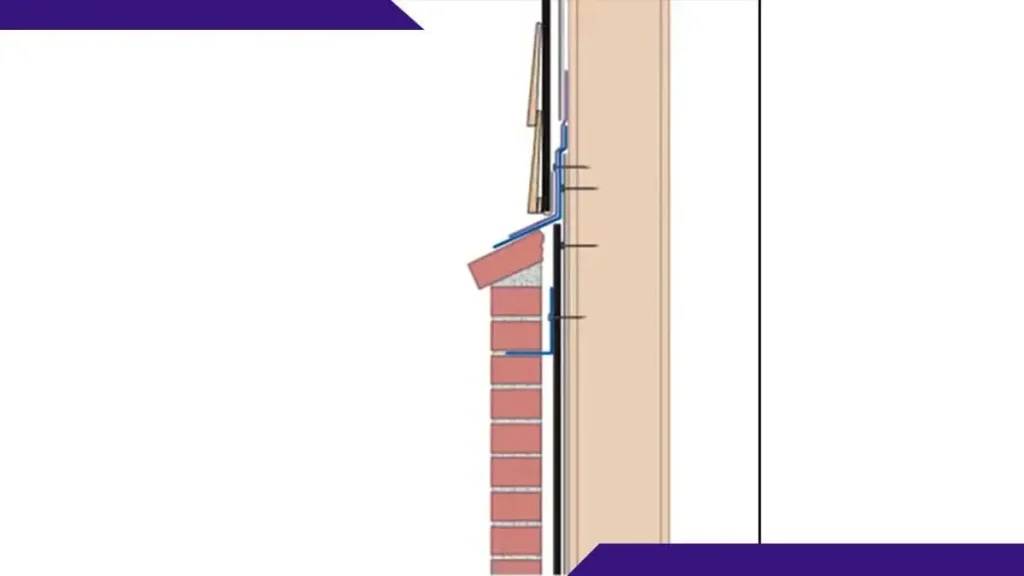
Initial Assessment and Planning
The first step in a brick-to-siding transition is conducting a thorough assessment of the existing brick structure. This includes evaluating the condition of the brickwork, mortar, and any underlying damage that may affect the siding installation. A contractor will examine whether the brick needs to be completely removed or if siding can be installed over the brick.
In some cases, homeowners may choose to leave the brick intact and use it as a foundation for attaching the siding. This can help reduce costs and streamline the installation process. However, complete removal is often the best option to prevent future complications if the brick is deteriorating, crumbling, or suffering from moisture issues.
During this phase, homeowners should also work with their contractor to choose the appropriate siding material, color, and design. This is the time to decide whether to add insulated siding, incorporate stone veneers or other accents, and finalize the overall aesthetic vision for the home’s exterior.
Removal of Existing Brick (If Necessary)
If the existing brick is in poor condition or if siding cannot be installed over it, the next step is the removal of the brick. This process involves carefully taking down the brick layers and mortar while ensuring that the structural integrity of the home is not compromised. Brick removal requires skilled labor, as improper removal techniques can cause damage to the underlying walls or framing.
Once the brick is removed, the contractor will assess the underlying wall to ensure it is sound and free from moisture damage, rot, or pests. Any repairs needed to the wall’s structure should be addressed at this stage before moving forward with the siding installation. It’s essential that the home’s frame is in good condition to provide a sturdy foundation for the new siding.
Wall Preparation and Insulation
With the brick removed or the surface prepared for siding, the next step is preparing the walls for siding installation. If the brick was left intact, a furring strip or moisture barrier is typically installed over the brick surface. Furring strips create a gap between the brick and siding, allowing for proper ventilation and preventing moisture buildup. Moisture barriers, such as house wrap or vapor barriers, are essential to protect the home from water infiltration, which could lead to rot, mold, or other issues.
At this point, insulation may also be added to improve the home’s energy efficiency. This can be in the form of rigid foam boards or insulated siding panels. Insulated siding helps reduce heat transfer through the walls, providing a thermal barrier that can lower heating and cooling costs. Proper insulation also enhances the overall comfort of the home by reducing drafts and temperature fluctuations.
Installing the Siding
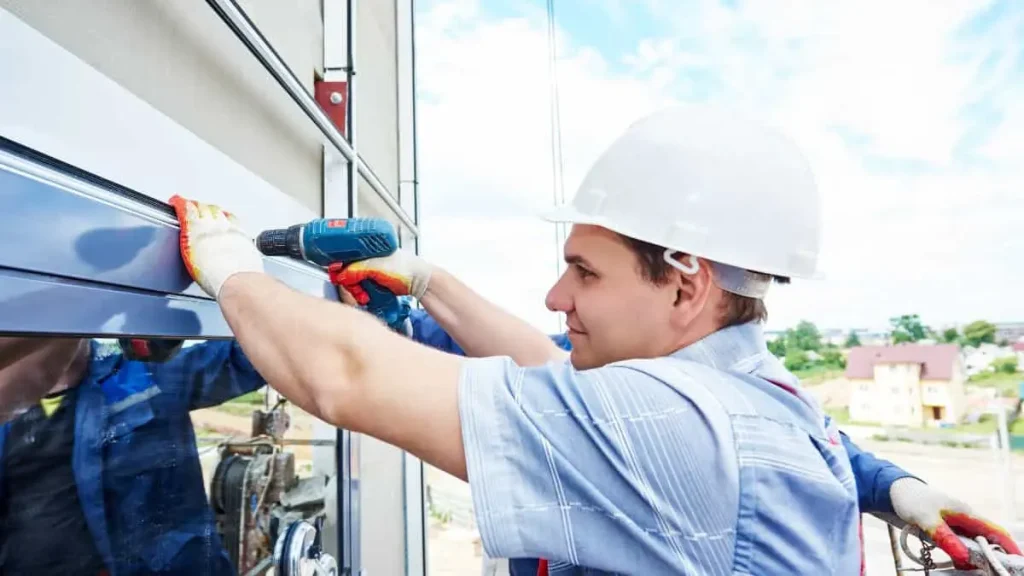
With the wall prepared and insulated, the actual siding installation begins. The chosen siding material, whether vinyl, fiber cement, wood, or another option, is carefully measured and cut to fit the dimensions of the home. The installation process varies slightly depending on the type of siding, but generally, it involves attaching each siding panel or plank to the wall, starting from the bottom and working upwards.
For materials like vinyl or fiber cement, each panel interlocks with the one below, creating a watertight seal that protects the home from the elements. Proper alignment and spacing are critical during this phase to ensure that the siding is level and secure. Any accent materials, such as stone veneers or decorative trim, are installed at this stage to enhance the home’s visual appeal.
During installation, contractors will also address openings like windows and doors by installing flashing and trim to create a seamless look and prevent water intrusion. Special care is taken around these areas to ensure that they are fully sealed and weatherproofed.
Read Also: T1 11 Siding Installed Horizontally
Adding Trim and Finishing Touches
Once the siding panels are in place, the contractor will focus on the finishing details. This includes installing trim around windows, doors, and rooflines to give the home a polished and cohesive appearance. Trim serves both an aesthetic and functional purpose, as it helps to seal the edges of the siding and provides additional protection against moisture infiltration.
Finishing touches may also include the installation of soffits, fascia, and gutters, which are important components of the home’s exterior system. Soffits, located under the roof’s overhang, help ventilate the attic space, while fascia boards support the lower edge of the roof and gutters. Together, these elements ensure that the home’s exterior is not only visually appealing but also well-protected from rain and other environmental factors.
During this phase, homeowners can also decide on any additional exterior features, such as shutters, decorative accents, or exterior lighting, to enhance the home’s curb appeal.
Final Inspection and Cleanup
After the siding installation and finishing touches are complete, the contractor will conduct a final inspection to ensure that everything has been installed correctly and meets the homeowner’s expectations. This includes checking for proper alignment, secure fastening, and weatherproofing around all edges, corners, and openings. Any adjustments or corrections are made at this stage to ensure that the siding is fully functional and aesthetically pleasing.
Once the inspection is completed, the contractor will remove any debris from the project, including old brick, mortar, and construction materials. The site is cleaned up, and the homeowner is left with a beautifully transformed exterior that enhances both the appearance and performance of their home.
The step-by-step process of transitioning from brick to siding requires careful attention to detail at every stage, from planning and removal to installation and finishing. By working with experienced professionals and following this process, homeowners can achieve a successful and long-lasting renovation.
Potential Challenges in Transitioning from Brick to Siding
While replacing brick with siding offers many benefits, homeowners should be aware of potential challenges that may arise during the process. These challenges can vary depending on the condition of the existing structure, the type of siding chosen, and other factors that impact both cost and installation.
Structural Concerns
One of the first challenges homeowners may face is related to the structural integrity of their home. When brick is removed, the underlying wall may reveal hidden issues such as moisture damage, mold, or compromised framing. Brick acts as a protective layer, so removing it can expose problems that were previously concealed. In some cases, the home’s framing may need reinforcement before siding can be installed.
If the brick is left in place and the siding is installed over it, there can still be structural concerns. Brick walls are heavy, and adding siding may place additional weight on the home’s structure. It’s essential to ensure that the walls can handle the extra load without compromising their integrity. Contractors must thoroughly assess the condition of the underlying wall and address any issues before proceeding with siding installation.
Moisture Management
Moisture management is a critical consideration when transitioning from brick to siding. Unlike brick, which is porous and allows moisture to evaporate naturally, siding materials such as vinyl or fiber cement require a proper moisture barrier to prevent water infiltration. If moisture becomes trapped between the siding and the wall, it can lead to serious problems like mold growth, rot, and damage to the home’s insulation and structure.
To mitigate these risks, a vapor barrier or house wrap must be installed to create a waterproof layer beneath the siding. Proper ventilation is also necessary to ensure that moisture can escape from behind the siding. Furring strips may be used to create space for air circulation, preventing moisture buildup. Failing to properly manage moisture during the siding installation process can lead to long-term damage and costly repairs down the line.
Brick Removal Complications
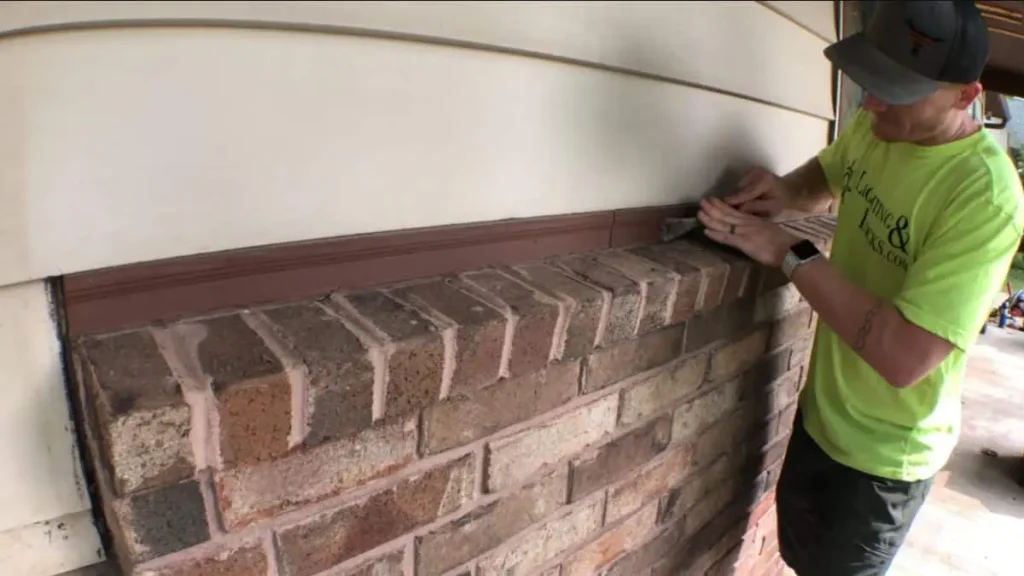
If the project involves removing the brick, this process can present several challenges. Brick removal is labor-intensive and requires specialized tools and techniques to ensure that the underlying structure is not damaged. Older homes with brittle or deteriorating brickwork may require extra care to prevent debris from falling and causing additional damage to the home or surrounding area.
There is also the issue of disposing of the brick material. In many areas, brick must be hauled away and properly disposed of, which can add to the overall project cost. Homeowners may need to coordinate with their contractor to arrange for debris removal or hire a separate waste disposal service. Additionally, if the brick removal uncovers any structural issues, such as foundation cracks or rotting framing, these problems must be addressed before the siding can be installed, which may cause delays and increase expenses.
Compatibility with Existing Architectural Features
A significant challenge when transitioning from brick to siding is ensuring that the new siding complements the existing architectural features of the home. Brick homes often feature distinct elements like chimneys, archways, and decorative brickwork, which can be difficult to replicate with siding materials. Homeowners must consider how the siding will interact with these features and whether additional modifications or design adjustments will be needed.
For example, if the home has a brick chimney or columns, these elements may either need to be removed, covered with siding, or integrated into the new design. This requires careful planning and possibly additional materials like stone veneer to create a cohesive look. In some cases, a combination of siding materials may be used to maintain the home’s original architectural style while modernizing its appearance.
Permitting and Local Building Codes
Another potential challenge is obtaining permits and complying with local building codes. Depending on the region and the extent of the renovation, homeowners may need to apply for permits before starting the brick-to-siding transition. Building codes may dictate specific requirements for siding materials, insulation, fire resistance, and energy efficiency, all of which must be adhered to during the project.
Failing to comply with these regulations can result in fines, project delays, or even having to redo parts of the installation. Working with a contractor who is familiar with local codes and permitting processes is essential to avoid these issues. Homeowners should also factor in the time it takes to secure the necessary permits when planning their project timeline.
Cost Overruns and Budget Concerns
While siding is generally more affordable than brick, the transition from brick to siding can still result in unexpected costs. As mentioned earlier, structural issues, moisture management concerns, and the removal of brick can all add to the overall expense of the project. Additionally, premium siding materials like fiber cement or stone veneer may be more costly than initially anticipated, especially if customizations or special finishes are required.
Homeowners should also consider the costs associated with labor. Installing siding over brick, removing brick, or addressing structural issues can all increase labor costs. It’s important to have a clear budget and contingency plan in place before starting the project to account for any unforeseen expenses. By working with an experienced contractor, homeowners can receive a detailed cost estimate that includes potential challenges and additional costs that may arise during the process.
Matching Siding to the Neighborhood
When replacing brick with siding, neighborhood aesthetics should be taken into account. Many brick homes are located in older neighborhoods or historic districts where brick is the dominant exterior material. Transitioning to siding can drastically alter the appearance of the home, making it stand out—potentially in a negative way—among neighboring properties.
In some areas, there may even be homeowners’ association (HOA) restrictions or guidelines that dictate the types of exterior materials that are permitted. Before making the transition, homeowners should check whether their neighborhood has any specific rules regarding exterior modifications. In cases where brick is the preferred or required material, homeowners may need to seek special permission or consider options like stone veneer or brick-like siding that closely mimics the original look.
Related: How to Fix Siding Too Close to Ground
Time and Weather Constraints
Finally, the timeframe and weather conditions can present challenges during the brick-to-siding transition. Siding installation is best done in favorable weather conditions, as extreme temperatures, rain, or snow can slow down the process or compromise the quality of the installation. Cold weather can make certain materials brittle, while moisture can interfere with adhesives and barriers used during installation.
Homeowners should plan their project for a time of year when the weather is most likely to cooperate. Additionally, depending on the size of the home and the complexity of the installation, the project may take several weeks to complete. Unexpected delays, whether due to weather or unforeseen structural issues, can extend the timeline, which may be inconvenient for homeowners who are living in the home during the renovation.
Cost Considerations for Brick-to-Siding Transition
When planning a transition from brick to siding, cost is one of the most critical factors homeowners must consider. This type of renovation project involves various expenses, from labor to materials, that can influence the final budget. Additionally, unexpected issues, such as structural repairs, can cause costs to rise.

Factors Affecting the Overall Cost
Several key factors influence the overall cost of transitioning from brick to siding. The first is the condition of the existing brick. If the brick is in poor condition and must be removed, this will increase labor costs and potentially require repairs to the underlying structure. Removing brick is labor-intensive and can add significant time to the project, impacting the total cost.
Another major factor is the size of the home. Larger homes naturally require more siding materials and longer labor hours, which will drive up the price. The complexity of the home’s exterior also plays a role; houses with more architectural details, such as dormers, columns, or chimneys, may require additional labor and materials to ensure a seamless transition from brick to siding.
Material choice is one of the biggest variables affecting the cost. Siding materials come in a wide range of prices, with vinyl typically being the most affordable option and fiber cement or natural wood siding on the higher end. Stone veneer or custom finishes can increase costs significantly, as these materials are both expensive and labor-intensive to install. Insulated siding, which improves energy efficiency, can also add to the overall budget.
In addition to material and labor, insulation and moisture management systems are essential components of a brick-to-siding transition. If insulation is added or upgraded during the project, this will increase the cost but can provide long-term energy savings. Similarly, installing vapor barriers or house wrap is necessary to prevent moisture damage, and this will also affect the final cost.
Labor Costs and Professional Expertise
Labor is a significant portion of the total cost of a brick-to-siding transition. Depending on the scope of the project, hiring a skilled contractor with experience in siding installation is crucial for ensuring high-quality results. The contractor will need to assess the home’s structure, prepare the walls, and install the siding according to the manufacturer’s specifications.
Homes with more intricate designs, multiple stories, or unique architectural features will require more labor, which can increase the cost. Additionally, if the brick must be removed, this process requires specialized labor to avoid damaging the home’s structural integrity. Removal also includes the cost of disposal, as brick and other debris need to be hauled away and properly disposed of, which may involve additional fees.
The expertise of the contractor is another key consideration. Working with a highly skilled contractor may come at a higher price, but it ensures the job is done correctly, minimizing the risk of future repairs or issues. Inadequate installation can lead to problems like moisture intrusion, which could require costly repairs down the line. Homeowners should prioritize quality over cost when selecting a contractor to ensure the longevity and performance of their new siding.
Material Costs: Siding Types and Prices
Material selection plays a crucial role in determining the total cost of a brick-to-siding transition. Vinyl siding is one of the most affordable options, making it popular among budget-conscious homeowners. The cost of vinyl siding varies based on thickness, quality, and whether it is insulated. Standard vinyl siding is usually the least expensive, while insulated versions offer greater energy efficiency at a higher cost.
For homeowners seeking a more durable and aesthetically appealing option, fiber cement siding is a popular choice. Although it comes with a higher price tag, fiber cement offers superior durability, fire resistance, and a more natural appearance than vinyl. However, it is heavier and more difficult to install, which can drive up labor costs.
Wood siding is another option, though it tends to be on the higher end of the cost spectrum due to its natural beauty and classic appeal. The price of wood siding varies depending on the type of wood used, with cedar and redwood being among the more expensive options. Wood also requires ongoing maintenance, such as painting or staining, which can add to long-term costs.
For those looking for a premium finish, stone veneer siding is an attractive but costly option. Stone veneer provides the look of natural stone without the same weight, making it a practical choice for siding installations. However, the material itself is expensive, and the installation process is labor-intensive, contributing to a higher overall cost.
Each siding material has its own set of benefits, and homeowners should consider not only the initial cost but also factors like durability, maintenance, and energy efficiency when making their selection.
Additional Expenses: Permits, Inspections, and Site Preparation
Beyond material and labor, homeowners should factor in additional expenses that can influence the final cost of their brick-to-siding transition. Depending on the location and scope of the project, obtaining building permits may be required. Local municipalities often have regulations regarding exterior renovations, and failing to secure the necessary permits can result in fines or delays. Permit costs vary by region and the size of the project.
Homeowners may also need to budget for inspections throughout the process. Inspections ensure that the installation meets local building codes and that the siding has been installed correctly, with proper ventilation, insulation, and moisture protection. Passing these inspections is essential to ensure the home is safe and compliant with local standards.
Site preparation is another area where costs can arise. If the brick must be removed, the underlying structure may require repairs or reinforcements before siding can be installed. This could include fixing any moisture damage, replacing rotted wood, or reinforcing the home’s framing. These repairs add time and expense to the project, but they are necessary to ensure that the new siding is securely attached and that the home remains protected.
Finally, homeowners should be prepared for the cost of debris removal and cleanup. Once the old brick is removed, it must be disposed of, and this often requires hiring a waste removal service. Proper cleanup ensures that the job site is safe and free of hazards once the project is completed.
Long-Term Cost Savings
While the initial cost of a brick-to-siding transition can be significant, it’s important to consider the long-term savings that siding can provide. One of the most immediate benefits is improved energy efficiency. Insulated siding, in particular, helps regulate indoor temperatures by reducing heat transfer through the walls. This leads to lower heating and cooling costs throughout the year, which can offset some of the upfront expenses over time.
Siding also typically requires less maintenance than brick, which can save homeowners money in the long run. Brick may require regular tuckpointing, cleaning, and repairs to address cracking or deterioration, especially in climates with extreme weather conditions. Siding, on the other hand, is often low-maintenance, with many materials designed to withstand harsh weather and resist fading or cracking. This reduced need for maintenance can lead to substantial savings on upkeep over the lifetime of the home.
For homeowners looking to boost their home’s value, a brick-to-siding transition can offer a high return on investment (ROI). Siding not only improves the appearance of the home but also enhances its curb appeal, making it more attractive to potential buyers. In many cases, homes with updated siding can command higher resale prices, especially if the new exterior is energy-efficient and visually appealing.
Overall, while the upfront costs of a brick-to-siding transition may be substantial, the potential for long-term savings in energy, maintenance, and increased property value make it a worthwhile investment for many homeowners.
Common FAQs about Brick to Siding Transition
Homeowners often have numerous questions about transitioning from brick to siding, as it involves a significant change in the home’s exterior. Addressing these common concerns can help homeowners better understand the process, costs, and potential outcomes, ensuring they make informed decisions about their renovation projects.
Is It Possible to Install Siding Directly Over Brick?
Yes, it is possible to install siding directly over brick, but it requires careful preparation and additional materials. The brick surface must be even and structurally sound to provide a suitable base for the siding. To create a proper installation surface, contractors often use furring strips or a plywood substrate to even out the brick and provide a stable foundation for the siding.
Additionally, moisture barriers and insulation may be added to ensure that the new siding system is weatherproof and energy-efficient. Without these preparations, siding installed directly onto brick may suffer from poor adhesion, moisture problems, or an uneven appearance.
What Type of Siding Is Best for Replacing Brick?
The best type of siding to replace brick largely depends on the homeowner’s preferences, budget, and the climate in which they live. For those looking for an affordable option, vinyl siding is a popular choice due to its low cost, low maintenance, and wide variety of styles and colors. Fiber cement siding is another excellent option for homeowners seeking durability, as it offers resistance to weather, pests, and fire.
Additionally, fiber cement can mimic the look of natural wood, making it appealing for those who want a more traditional appearance. Wood siding provides a classic, natural aesthetic but may require more maintenance and comes at a higher price point. Finally, stone veneer siding offers a high-end look similar to brick but at a lower cost, making it a desirable option for those who want to maintain a natural, textured appearance.
How Long Does a Brick to Siding Transition Take?
The timeline for transitioning from brick to siding varies depending on the size of the home, the extent of the project, and whether the brick needs to be removed. If the brick is being left in place and siding is installed over it, the process is generally quicker and can be completed in a few weeks.
However, if the brick needs to be removed, the project may take longer, as this process is labor-intensive and requires more preparation work. On average, homeowners should expect the transition to take anywhere from 2 to 6 weeks. Weather conditions, the complexity of the home’s design, and any unforeseen structural issues can also impact the timeline. Working closely with a professional contractor will help establish a more accurate timeline for the project.
Will Removing Brick Damage the Home’s Structure?
If done properly by experienced contractors, removing brick should not damage the home’s structure. However, brick removal must be handled with care, as it can expose the underlying framework, which may require reinforcement or repairs before siding is installed. If the framing is in good condition, the process should be relatively straightforward.
If issues such as moisture damage, rotting wood, or structural weaknesses are uncovered during the removal, these problems must be addressed before the siding is applied. Homeowners should be prepared for the possibility of additional repairs when brick is removed, especially in older homes where underlying issues may be more common.
Will Siding Reduce the Home’s Value Compared to Brick?
Siding can enhance a home’s value, particularly if it replaces deteriorating or outdated brick. Modern siding materials, especially those designed to be energy-efficient or offer high durability, can increase curb appeal and attract potential buyers. Siding is also available in a wide range of colors, finishes, and styles, allowing homeowners to create a more updated and attractive exterior. Homes with new, well-installed siding are often valued higher than homes with aging or poorly maintained brick exteriors.
Additionally, siding’s low-maintenance requirements and improved insulation properties can appeal to buyers looking for energy efficiency and cost savings. However, in certain neighborhoods or historic districts, brick may be preferred, and transitioning to siding could affect resale value. Homeowners should consider the local real estate market and neighborhood aesthetic before making this decision.
Does Siding Offer Better Insulation than Brick?
Siding can offer better insulation than brick, especially when combined with an insulated backing or foam insulation panels. While brick is dense and can help regulate temperature, it is not an effective insulator on its own. Adding modern siding with insulation can significantly improve a home’s energy efficiency, reducing heating and cooling costs. Insulated vinyl siding, for example, includes a foam layer that helps prevent heat transfer, keeping homes cooler in the summer and warmer in the winter. Fiber cement siding, when installed with proper insulation, can also enhance thermal performance.
How Much Does It Cost to Transition from Brick to Siding?
The cost of transitioning from brick to siding depends on several factors, including the size of the home, the type of siding chosen, and whether the brick needs to be removed. On average, the cost can range from $10,000 to $30,000 or more, with the lower end representing smaller homes and more affordable siding options, such as vinyl. Fiber cement siding is typically more expensive, as are premium materials like wood or stone veneer. Brick removal adds to the cost due to the labor involved and the need to dispose of the debris.
Additional expenses may include repairs to the underlying structure, moisture barriers, and insulation. Homeowners should obtain detailed quotes from contractors to understand the full scope of the project and potential costs.
Conclusion
Transitioning from brick to siding is a significant home improvement project that can enhance the aesthetic appeal, energy efficiency, and overall value of a property. Homeowners often choose this transition for various reasons, including the desire for a modern look, lower maintenance requirements, and improved insulation. By understanding the benefits of siding, the various options available, and the detailed process involved, homeowners can make informed decisions that align with their goals.
Although challenges such as cost considerations, structural concerns, and potential disruptions during the transition may arise, careful planning and collaboration with experienced professionals can help mitigate these issues. Additionally, being aware of the common questions and concerns surrounding this project ensures that homeowners feel prepared and empowered as they embark on their renovation journey.
Ultimately, transitioning from brick to siding offers an opportunity to revitalize a home’s exterior, making it more inviting and energy-efficient while increasing its market value. With the right materials and approach, this renovation can provide lasting benefits for homeowners and create a beautiful and functional living space for years to come.

